service indicator CHEVROLET S10 1996 2.G Owners Manual
[x] Cancel search | Manufacturer: CHEVROLET, Model Year: 1996, Model line: S10, Model: CHEVROLET S10 1996 2.GPages: 375, PDF Size: 20.73 MB
Page 74 of 375
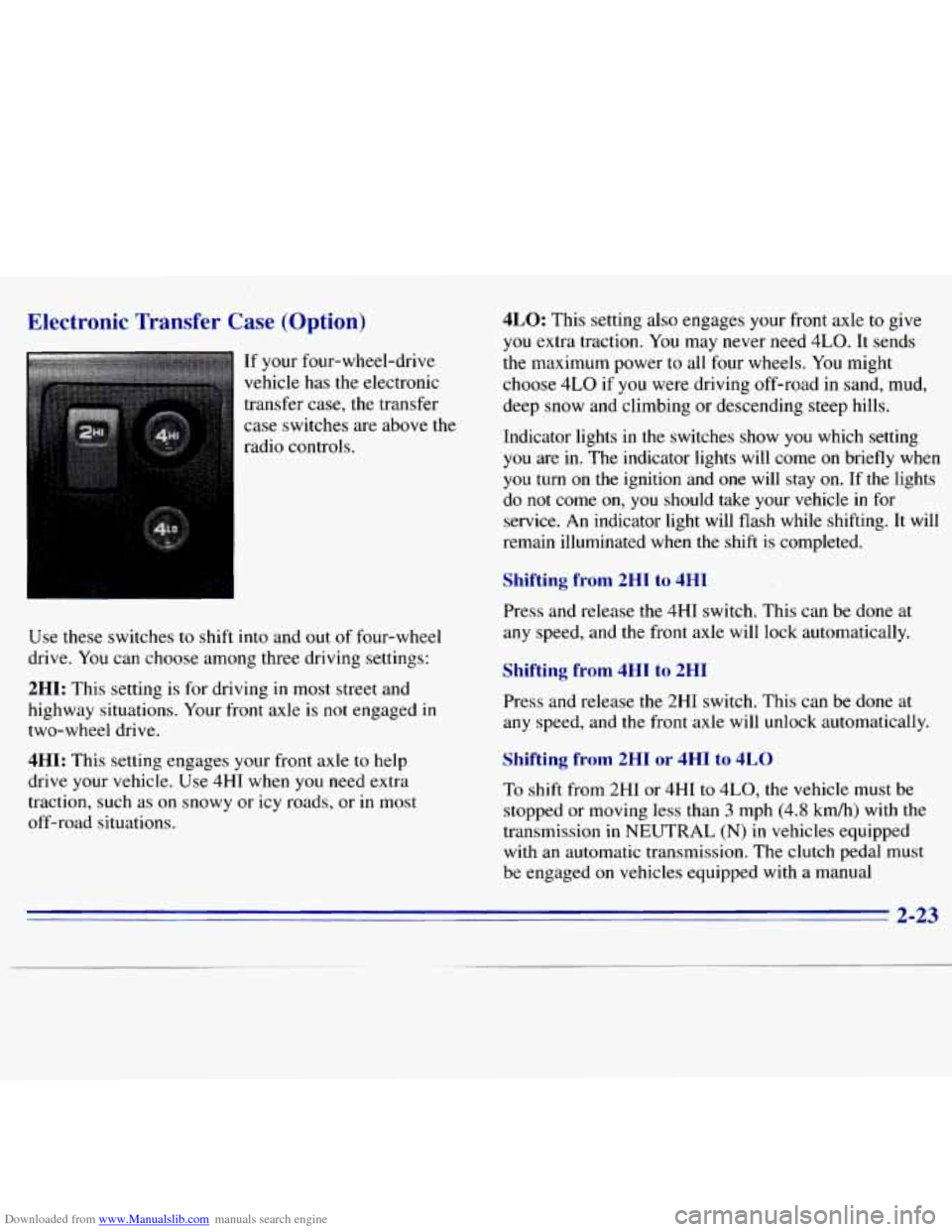
Downloaded from www.Manualslib.com manuals search engine Electronic Transfer Case (Option)
If your four-wheel-drive
vehicle has the electronic
transfer case, the transfer case switches are above the
radio controls.
Use these switches
to shift into and out of four-wheel
drive. You can choose among three driving settings:
2HI: This setting is for driving in most street and
highway situations. Your front axle is not engaged in
two-wheel drive.
4HI: This setting engages your front axle to help
drive your vehicle.
.Use 4HI when you need extra
traction, such as on snowy or icy roads, or
in most
off-road situations.
4LO: This setting also engages your front axle to give
you extra traction. You may never need
4LO. It sends
the maximum power to all four wheels.
You might
choose
4LO if you were driving off-road in sand, mud,
deep snow and climbing or descending steep hills.
Indicator lights in the switches show
you which setting
you are in. The indicator lights will come on briefly when
you turn on the ignition and one will stay on. If the lights
do
not come on, you should take your vehicle in for
service.
An indicator light will flash while shifting. It will
remain illuminated when
the shift is completed.
Shifting from 2HI to 4HI
Press and release the 4HI switch. This can be done at
any speed, and the front axle will lock automatically.
Shifting from 4HI to 2HI
Press and release the 2HI switch. This can be done at
any speed, and the front axle will unlock automatically.
Shifting from 2HI or 4HI to 4LO
To shift from 2HI or 4HI to 4L0, the vehicle must be
stopped or moving less than
3 mph (4.8 kmh) with the
transmission
in NEUTRAL (N) in vehicles equipped
with an automatic transmission. The clutch pedal
must
be engaged on vehicles equipped with a manual
2-23
Page 75 of 375
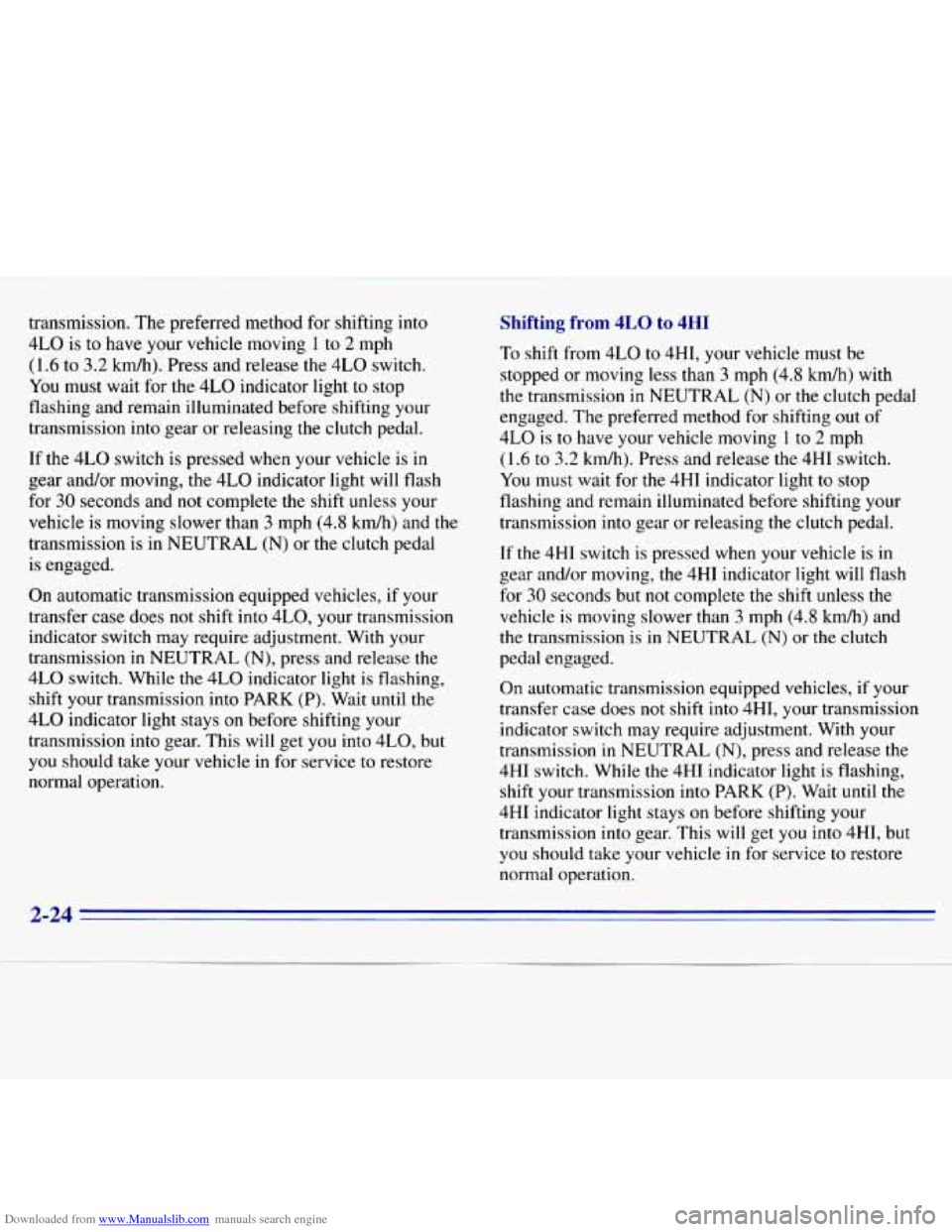
Downloaded from www.Manualslib.com manuals search engine transmission. The preferred method for shifting into
4LO is to have your vehicle moving 1 to 2 mph
(1.6 to 3.2
kmh). Press and release the 4LO switch.
You must wait for the 4LO indicator light
to stop
flashing and remain illuminated before shifting your
transmission into gear or releasing the clutch pedal.
If the 4LO switch is pressed when your vehicle is in
gear and/or moving, the 4LO indicator light will flash
for
30 seconds and not complete the shift unless your
vehicle is moving slower than
3 mph (4.8 km/h) and the
transmission is in NEUTRAL (N) or the clutch pedal
is engaged.
On automatic transmission equipped vehicles, if your
transfer
case does not shift into 4L0, your transmission
indicator switch may require adjustment. With your
transmission
in NEUTRAL (N), press and release the
4LO switch. While the 4LO indicator light is flashing,
shift your transmission into
PARK (P). Wait until the
4LO indicator light stays
on before shifting your
transmission into gear. This will get
you into 4L0, but
you should take your vehicle in for service
to restore
normal operation.
Shifting from 4LO to 4HI
To shift from 4LO to 4H1, yo Iur vehicle must be
stopped
or moving less than 3 mph (4.8 kmh) with
the transmission in NEUTRAL
(N).or the clutch pedal
engaged. The preferred method for shifting out
of
4LO is to have your vehicle moving 1 to 2 mph
(1.6 to 3.2 km/h). Press and release the 4HI switch.
You must wait for the 4HI indicator light to stop
flashing and remain illuminated before shifting your
transmission into gear or releasing the clutch pedal.
If the 4HI switch is pressed when your vehicle is in
gear and/or moving, the 4HI indicator light will flash
for 30 seconds but not complete the shift unless the
vehicle
is moving slower than 3 mph (4.8 kmh) and
the transmission is in
NEUTRAL (N) or the clutch
pedal engaged.
On automatic transmission equipped vehicles, if your
transfer case does
not shift into 4H1, your transmission
indicator switch may require adjustment. With your
transmission in NEUTRAL
(N), press and release the
4HI switch. While the 4HI indicator light is flashing,
shift your transmission into PARK
(P). Wait until the
4HI indicator light stays on before shifting your
transmission into gear. This will get
you into 4H1, but
you should take your vehicle
in for service to restore
normal operation.
2-24
Page 105 of 375
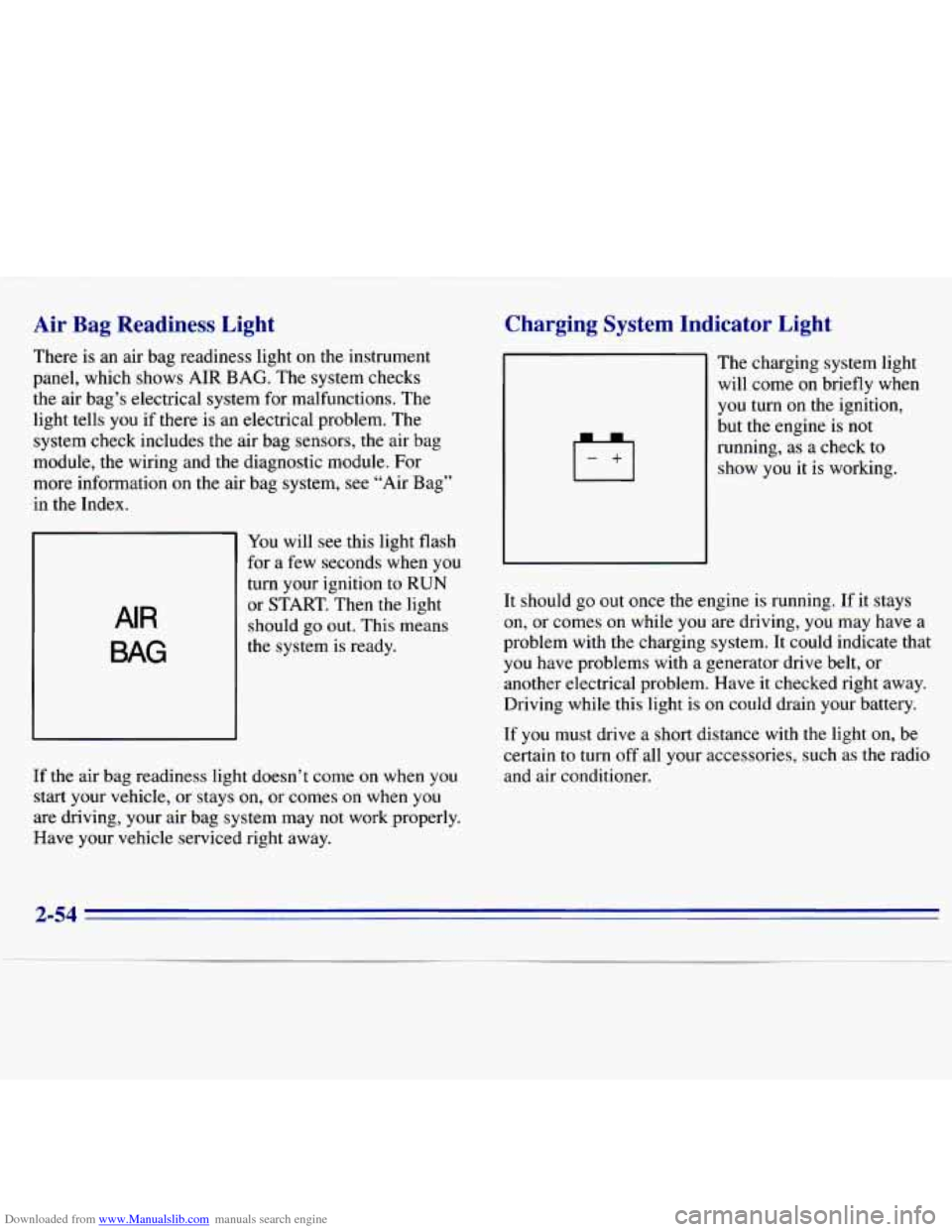
Downloaded from www.Manualslib.com manuals search engine Air Bag Readiness Light
There is an air bag readiness light on the instrument
panel, which shows AIR
BAG. The system checks
the air bag’s electrical system for malfunctions. The
light tells
you if there is an electrical problem. The
system check includes the air bag sensors, the air
bag
module, the wiring and the diagnostic module. For
more information on the air bag system, see “Air Bag”
in the Index.
AIR
BAG
You will see this light flash
for a few seconds when you
turn your ignition to RUN
or START. Then
the light
should
go out. This means
the system is ready.
If the air bag readiness light doesn’t come
on when you
start your vehicle, or stays on, or comes on when you
are driving, your air bag system may not work properly.
Have your vehicle serviced right away.
Charging System Indicator Light
The charging system light
will come
on briefly when
you turn on the ignition,
but the engine is not
running, as
a check to
show you it is working.
It should go out once the engine
is running. If it stays
on, or comes on while you are driving, you may have a
problem with the charging system. It could indicate that
you have problems with a generator drive belt, or
another electrical problem. Have
it checked right away.
Driving while this light is on could drain your battery.
If you must drive a short distance with the light on, be
certain to turn off all your accessories, such as the radio
and air conditioner.
2-54
Page 108 of 375
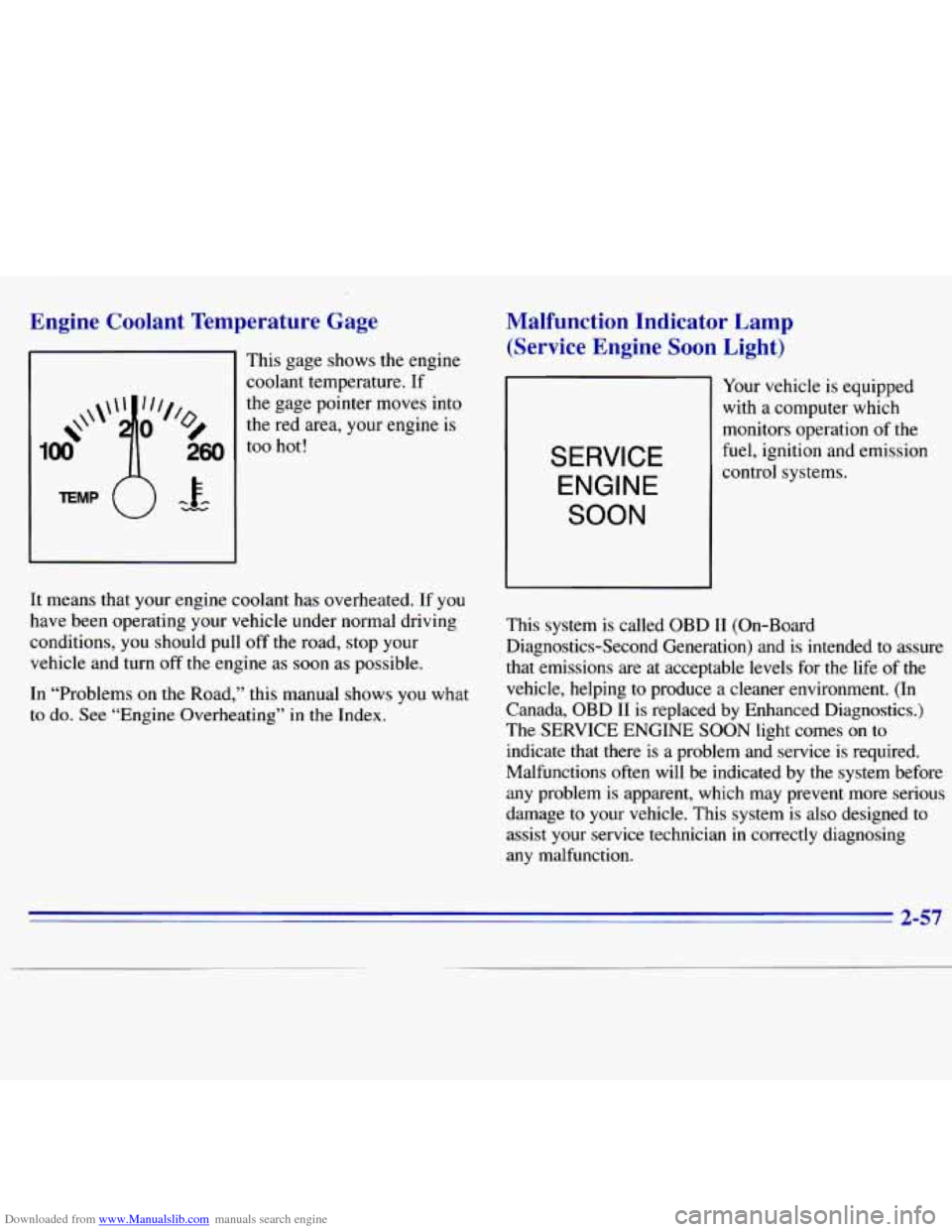
Downloaded from www.Manualslib.com manuals search engine Engine Coolant Temperature Gage
This gage shows the engine
coolant temperature.
If
the gage pointer moves into
the red area, your engine is
260 too hot!
TEMP
Malfunction Indicator Lamp
(Service Engine Soon Light)
Your vehicle is equipped
with a computer which
monitors operation of the
fuel, ignition and emission
SERVICE
ENGINE
SOON
control systems.
It means that your engine coolant has overheated. If you
have been operating your vehicle under normal driving
conditions, you should pull off the road, stop your
vehicle and turn off
the engine as soon as possible.
In “Problems on the Road,” this manual shows you
what
to do. See “Engine Overheating” in the Index. This
system is called
OBD I1 (On-Board
Diagnostics-Second Generation) and is intended
to assure
that emissions are at acceptable levels for the life of the
vehicle, helping to produce a cleaner environment.
(In
Canada, OBD I1 is replaced by Enhanced Diagnostics.)
The SERVICE ENGINE SOON light comes on to
indicate that there is a problem and service
is required.
Malfunctions often will be indicated by the system before
any problem is apparent, which may prevent more serious
damage to your vehicle. This system
is also designed to
assist your service technician
in correctly diagnosing
any malfunction.
2-57
Page 229 of 375
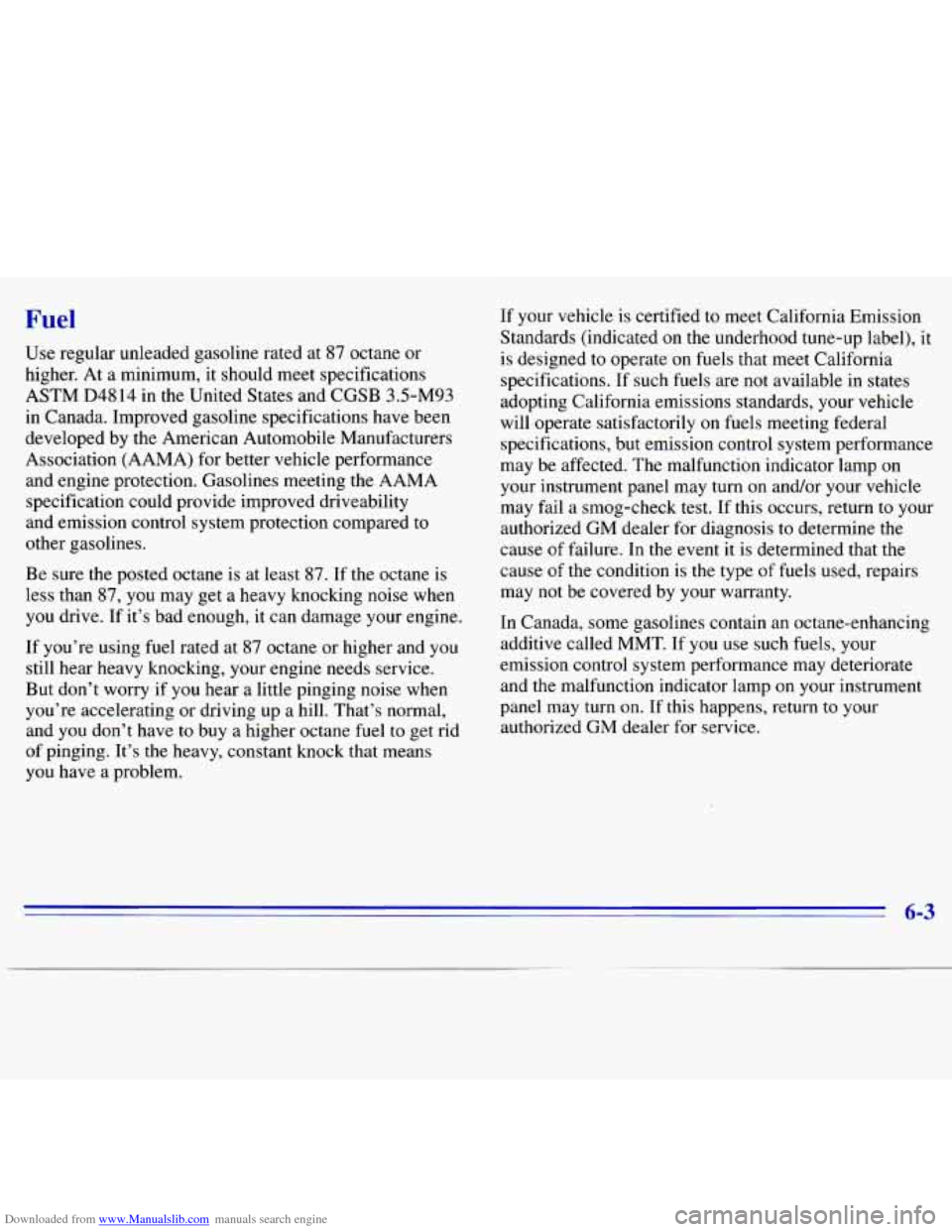
Downloaded from www.Manualslib.com manuals search engine Fu
Use regular unleaded gasoline rated at 87 octane or
higher. At a minimum, it should meet specifications
ASTM
D4814 in the United States and CGSB 3.5-M93
in Canada. Improved gasoline specifications have been
developed by the American Automobile Manufacturers
Association (AAMA) for better vehicle performance
and engine protection. Gasolines meeting the AAMA
specification could provide improved driveability
and emission control system protection compared
to
other gasolines.
Be sure the posted octane is at least
87. If the octane is
less than 87, you may get a heavy knocking noise when
you drive. If it’s bad enough, it
can damage your engine.
If you’re using fuel rated at 87 octane or higher and you
still hear heavy knocking, your engine needs service.
But don’t worry if you hear a little pinging noise when
you’re accelerating or driving up
a hill. That’s normal,
and you don’t have
to buy a higher octane fuel to get rid
of pinging. It’s the heavy, constant knock that means
you have a problem. If
your vehicle is certified to meet California Emission
Standards (indicated on the underhood tune-up label), it
is designed to operate
on fuels that meet California
specifications. If such fuels are not available
in states
adopting California emissions standards, your vehicle
will operate satisfactorily on fuels meeting federal
specifications, but emission control system performance
may be affected. The malfunction indicator lamp on
your instrument panel may turn on and/or your vehicle
may fail a smog-check test. If this occurs, return
to your
authorized GM dealer for diagnosis to determine the
cause of failure. In the event it
is determined that the
cause of the condition is the type of fuels used, repairs
may not be covered by your warranty.
In Canada, some gasolines contain an octane-enhancing
additive called
MMT. If you use such fuels, your
emission control system performance may deteriorate
and the malfunction indicator lamp on your instrument
panel may turn on. If this happens, return
to your
authorized
GM dealer for service.
6-3
Page 370 of 375
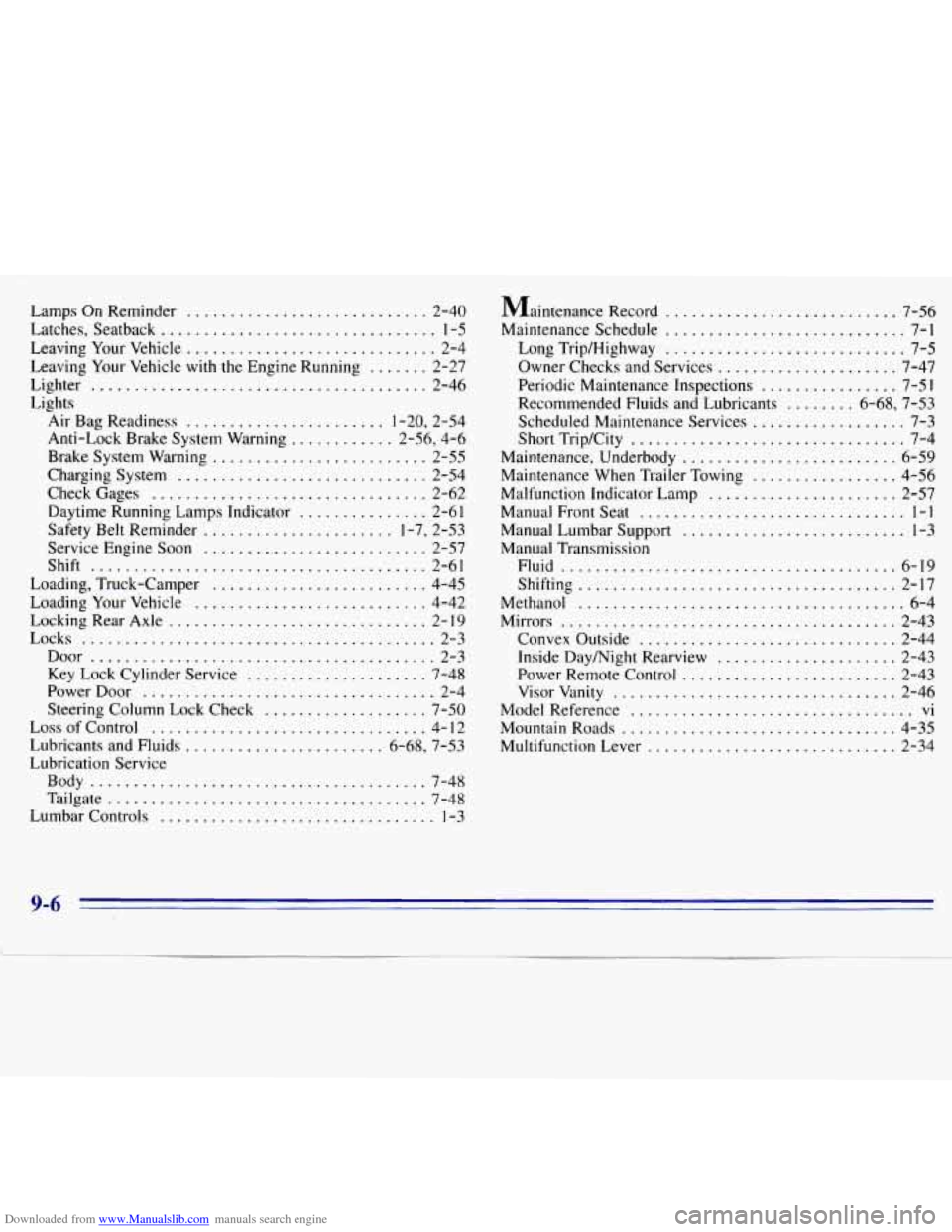
Downloaded from www.Manualslib.com manuals search engine Lamps On Reminder ............................ 2-40
Leaving Your Vehicle
............................. 2-4
Latches. Seatback
................................ 1-5
Leaving
Your Vehicle with the Engine Running ....... 2-27
Lighter
....................................... 2-46
Lights Air Bag Readiness
....................... 1-20. 2-54
Anti-Lock Brake System Warning
............ 2.56. 4.6
Brake System Warning
......................... 2-55
Charging System
............................. 2-54
CheckGages
................................ 2-62
Daytime Running Lamps Indicator
............... 2-61
Safety Belt Reminder
...... .. ............... 1.7. 2.53
Service Engine Soon
.......................... 2-57
Shift
....................................... 2-61
Loading. Truck-Camper
......................... 4-45
Loading
Your Vehicle ........................... 4-42
Locking Rear Axle
.............................. 2- 19
Locks ......................................... 2-3
Door
........................................ 2-3
Key Lock Cylinder Service
..................... 7-48
PowerDoor
.................................. 2-4
Steering Column Lock Check
................... 7-50
Loss of Control
................................ 4- I2
Lubricants and Fluids
....................... 6-68. 7.53
Lubrication Service
Body
....................................... 7-48
Tailgate
..................................... 7-48
Lumbar Controls
................................ 1-3 Maintenance
Record
........................... 7-56
Maintenance Schedule
............................ 7-1
Long Trip/Highway ............................ 7-5
Owner Checks and Services
..................... 7-47
Periodic Maintenance Inspections
................ 7-51
Recommended Fluids and Lubricants ........ 6.68. 7.53
Scheduled Maintenance Services
.................. 7-3
Short Trip/City
................................ 7-4
Maintenance. Underbody
......................... 6-59
Maintenance When Trailer Towing
................. 4-56
Malfunction Indicator Lamp
...................... 2-57
Manual Front Seat
............................... 1-1
Manual Lumbar Support .......................... 1-3
Manual Transmission Fluid
....................................... 6-19
Shifting
..................................... 2-17
Methanol
...................................... 6-4
Mirrors
....................................... 2-43
Convex Outside
.............................. 2-44
Inside Daymight Rearview
..................... 2-43
Power Remote Control
......................... 2-43
Visor
Vanity ................................. 2-46
Model Reference
................................. vi
Mountain Roads ................................ 4-35
Multifunction Lever
............................. 2-34
9-6
I